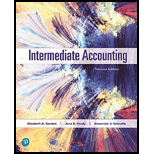
Intermediate Accounting (2nd Edition)
2nd Edition
ISBN: 9780134730370
Author: Elizabeth A. Gordon, Jana S. Raedy, Alexander J. Sannella
Publisher: PEARSON
expand_more
expand_more
format_list_bulleted
Textbook Question
Chapter 3, Problem 3.6Q
Does IFRS require that companies disclose their accounting policies? Explain.
Expert Solution & Answer
Want to see the full answer?
Check out a sample textbook solution
Students have asked these similar questions
Please explain the correct approach for solving this general accounting question.
Zebrix Ltd. has an inventory period of 55 days, an accounts receivable period of 10 days, and an accounts payable period of 6 days. The company's annual sales are $208,400. How many times per year does the company turn over its accounts receivable?
Lika company issues 2,000 shares of $10 par value common stock for $25 per share. What amount should be credited to the Common Stock account and to the Additional Paid-in Capital account?
Chapter 3 Solutions
Intermediate Accounting (2nd Edition)
Ch. 3 - Prob. 3.1QCh. 3 - Prob. 3.2QCh. 3 - Does U.S. GAAP require that companies disclose...Ch. 3 - Does IFRS require that companies disclose...Ch. 3 - Prob. 3.5QCh. 3 - Does IFRS require that companies disclose their...Ch. 3 - Prob. 3.7QCh. 3 - Prob. 3.8QCh. 3 - Prob. 3.9QCh. 3 - Prob. 3.10Q
Ch. 3 - Prob. 3.11QCh. 3 - What is the Basis for Conclusions and where can...Ch. 3 - Prob. 3.13QCh. 3 - Prob. 3.14QCh. 3 - Prob. 3.1BECh. 3 - Judgment in Accounting for Plant and Equipment....Ch. 3 - Match Each Cognitive Bias Below with its...Ch. 3 - Prob. 3.4BECh. 3 - Prob. 3.5BECh. 3 - Prob. 3.6BECh. 3 - Prob. 3.7BECh. 3 - Codification Research. Referencing Appendix A,...Ch. 3 - Prob. 3.9BECh. 3 - Prob. 3.10BECh. 3 - Exercises E3-1. Accounting Policy Disclosures. To...Ch. 3 - Cognitive Bias. A team of accounting students is...Ch. 3 - Cognitive Bias. A team of accounting students is...Ch. 3 - Authoritative Literature. Provide the reference to...Ch. 3 - Authoritative Literature. Provide the reference to...Ch. 3 - Authoritative Literature. To what entity types...Ch. 3 - Authoritative Literature. How does FASB define...Ch. 3 - Prob. 3.8ECh. 3 - Prob. 1JCCh. 3 - Prob. 2JCCh. 3 - Prob. 1SSCCh. 3 - Surfing the Standards Case 2: Inventory...Ch. 3 - Basis for Conclusions Case 1: Judgment and...Ch. 3 - Basis for Conclusions Case 2: Income Statement or...
Knowledge Booster
Learn more about
Need a deep-dive on the concept behind this application? Look no further. Learn more about this topic, accounting and related others by exploring similar questions and additional content below.Similar questions
- Can you help me solve this general accounting question using the correct accounting procedures?arrow_forwardCan you solve this general accounting question with accurate accounting calculations?arrow_forwardPlease provide the correct answer to this general accounting problem using accurate calculations.arrow_forward
- I need help solving this general accounting question with the proper methodology.arrow_forwardI need help finding the accurate solution to this general accounting problem with valid methods.arrow_forwardPlease provide the answer to this financial accounting question using the right approach.arrow_forward
- I am looking for a reliable way to solve this financial accounting problem using accurate principles.arrow_forwardI need help with this financial accounting problem using proper accounting guidelines.arrow_forwardCan you demonstrate the accurate steps for solving this financial accounting problem with valid procedures?arrow_forward
arrow_back_ios
SEE MORE QUESTIONS
arrow_forward_ios
Recommended textbooks for you
 Intermediate Accounting: Reporting And AnalysisAccountingISBN:9781337788281Author:James M. Wahlen, Jefferson P. Jones, Donald PagachPublisher:Cengage LearningPrinciples of Accounting Volume 1AccountingISBN:9781947172685Author:OpenStaxPublisher:OpenStax College
Intermediate Accounting: Reporting And AnalysisAccountingISBN:9781337788281Author:James M. Wahlen, Jefferson P. Jones, Donald PagachPublisher:Cengage LearningPrinciples of Accounting Volume 1AccountingISBN:9781947172685Author:OpenStaxPublisher:OpenStax College

Intermediate Accounting: Reporting And Analysis
Accounting
ISBN:9781337788281
Author:James M. Wahlen, Jefferson P. Jones, Donald Pagach
Publisher:Cengage Learning

Principles of Accounting Volume 1
Accounting
ISBN:9781947172685
Author:OpenStax
Publisher:OpenStax College
ACCOUNTING BASICS: Debits and Credits Explained; Author: Accounting Stuff;https://www.youtube.com/watch?v=VhwZ9t2b3Zk;License: Standard Youtube License